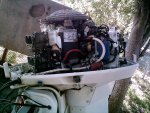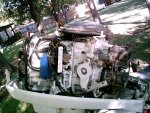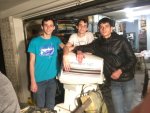This thread will document the work I’m doing on a 1982 crossflow V4 140 hp Johnson: J140TLCNB.
i picked up up the motor today off of Craigslist. All I know so far is that it turns over on the starter, has even compression (about 95 psi on my harbor freight gauge), has spark on both banks, and the tilt/trim works if you jump it directly to the battery. The guy I bought it from had pulled it from a salvage boat, the last registration sticker was 2005. So I t probably hasn’t run in 12 years.
I’ve got a lot of work to do.
The plan is to start with the water pump/cooling system, ignition system, and then fuel system. Then hit the key and listen to her purr. ;-)
Nope, scratch that. The plan is, clean the work bench, finish a couple of honey-do’s to keep Mama happy, then start in that list.
I bought this motor to replace a ‘96 that dropped a cylinder. My uncle had one a late ‘70’s Johnson 140 just like this one, so I already have a sentimental attachment to this project.
Climb aboard, and come along for the ride.
i picked up up the motor today off of Craigslist. All I know so far is that it turns over on the starter, has even compression (about 95 psi on my harbor freight gauge), has spark on both banks, and the tilt/trim works if you jump it directly to the battery. The guy I bought it from had pulled it from a salvage boat, the last registration sticker was 2005. So I t probably hasn’t run in 12 years.
I’ve got a lot of work to do.
The plan is to start with the water pump/cooling system, ignition system, and then fuel system. Then hit the key and listen to her purr. ;-)
Nope, scratch that. The plan is, clean the work bench, finish a couple of honey-do’s to keep Mama happy, then start in that list.
I bought this motor to replace a ‘96 that dropped a cylinder. My uncle had one a late ‘70’s Johnson 140 just like this one, so I already have a sentimental attachment to this project.
Climb aboard, and come along for the ride.

























